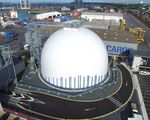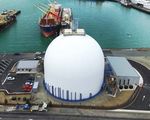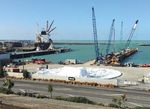Holcim New Zealand Cement Terminal - 2016 Outstanding International Project - American Shotcrete ...
←
→
Page content transcription
If your browser does not render page correctly, please read the page content below
2016 Outstanding International Project
Holcim New Zealand
Cement Terminal
By Benjamin Davis
I
n 2013, Holcim New Zealand, a part of the Lafarge- 2014). Two sites were chosen for Holcim’s domes. On the
Holcim Group, set out to design and build two cement South Island, the dome was to be built in Timaru, a port city
storage terminals in New Zealand. With earthquake approximately 93 miles (150 km) south of Christchurch. The
devastation in mind following severe earthquakes in other dome would be located on the North Island in the most
2010 (Stuff Reporters 2010) and 2011 (CNN 2011), finding populous city in the country, Auckland, with a regional popu-
a durable bulk storage structure resilient enough to lation of over 1.4 million (New Zealand Government, 2013).
handle seismic events and a company with a verifiable This article focuses on the project built in Timaru, on New
track record of building such buildings was paramount. Zealand’s South Island, although both domes are pictured
Holcim described the entire project as consisting of and explained in this article.
two 33,000 ton (30,000 tonne) capacity dome silos, two
660 ton/hr (600 tonne/hr) pneumatic ship unloaders, a WHY A SHOTCRETE DOME?
720 ton/hr (650 tonne/hr) ship loader at Timaru, and bulk Although Domtec had built for Holcim in other parts of
cement tanker loading facilities, all supported by equipment the world, this was the first shotcrete dome to be built for the
auxiliary buildings, office buildings, roadways, security, storage of cement in Australasia and was quite an innovative
and dispatch facilities for a total cost of NZ$105 million design and technique. Holcim cited several reasons for choo-
(USD$70.8 million) (Williams and Cowie 2016). sing a dome over traditional slip-form or jump-form cylin-
The storage domes would be built on two ports and had drical concrete silos, steel silos, or warehouse-type storage
to be aesthetically pleasing, environmentally friendly, cost- silos. Economy and speed of construction were the key
effective, and allow as sustainable an operation as pos- factors in choosing a dome, but there were others, such as:
sible. Their thorough evaluation of various types of storage • Control over environmental impact during construction
structures selected concrete domes as the best choice. In and operation phases due to the weather tightness and
the end, Domtec International was chosen as the preferred dust control properties of the dome. The external air-form
dome vendor in a “Best for Project” approach (Downer Group and the polyurethane foam lining provide excellent insula-
Fig. 1: Aerial view of Holcim Cement Terminal in Auckland, New Fig. 2: Aerial view of Holcim Cement Terminal in Timaru, New
Zealand. Dome is 135.2 ft (41.2 m) diameter and 90.2 ft (27.5 m) Zealand. Dome is 118.1 ft (36 m) in diameter and 103.3 ft
tall and stores 33,000 tons (30,000 tonnes) of cement powder (31.5 m) tall and stores 33,000 tons (30,000 tonnes) of cement
and used 1400 yd 3 (1100 m 3) of shotcrete to construct powder and used 1923 yd 3 (1470 m 3) of shotcrete to construct
26 Shotcrete | Winter 2017 www.shotcrete.orgFig. 3: Street view of Timaru cement storage dome. Aesthetics
were a major consideration when deciding on a storage solution.
The dome durability, white fabric color, insulation, price, and
Domtec’s reputation also figured into the contract award
tion and isolation properties, a benefit during construc-
tion and operation of the dome.
• Dome silos can be fitted with a complete reclaim floor,
guaranteeing 98% extraction rates.
• The dome shape provides a high volume of storage within
a relatively small footprint.
• This port had height and space constraints. The dome
could achieve the tonnage required within a footprint and
height that would work.
• The dome shape is inherently strong because of the Fig. 4: View of dome apex from inside of dome. When
seamless blending of the wall and roof. This provides completed, each apex was designed to support 150,000 lb
excellent structural integrity, resistance to earthquakes, (approximately 62 tons [68 tonnes]) without any interior supports
and severe weather conditions. This inherent strength
also allows the cement to be placed high against the
walls and roof.
• The technique of using shotcrete allows efficient and
economical construction (eliminating the need for form-
work, shoring, and waste). It also enables rapid con-
struction of the domes regardless of weather conditions
because after the inflatable form is erected, all works are
performed inside the dome.
• Domes are ideal for combining with pneumatic extraction
equipment from ships, to dome, to truck loading, and can
accommodate high-volume filling and discharge rates.
• The dome supports heavy loads on the apex and asym-
metrical loading against the walls, allowing side dis-
charge and avoiding sub-grade reclaim tunnels. Each of
the Holcim domes were designed to support 150,000 lb
(68,000 kg) without any interior bracing or exterior bents.
• Building authorities had no experience with dome con-
struction, but the lead contractor, together with Domtec
International, put together a presentation that answered
all questions and alleviated all risk and safety concerns
(Williams and Cowie 2016).
DOME DESIGN
The dome storage building went through a strict peer
review process that involved structural engineers in five
countries on three continents. The dome was engineered
Fig. 5: Finished interior wall of dome. The dome used roughly
using ACI, New Zealand/Australia, and Eurocode standards 1923 yd 3 (1470 m 3) of shotcrete
www.shotcrete.org Winter 2017 | Shotcrete 27and codes to ensure all peer review engineers had a good DOME CONSTRUCTION
understanding of loads and forces. After looking through the Construction of a concrete dome with an air form is rela-
peer reviewed drawings, the owner and founder of Domtec, tively unique compared to conventional methods of concrete
who has been in the dome business for over 35 years, construction but allows for rapid construction and superior
remarked, “This will be the most stoutly constructed cement strength and durability. The method for building domes
storage dome in the world.” involves inflating a heavy-duty industrial fabric, which serves
as a formwork or “air form.” Domtec’s DomeSkin™ air forms
are each custom designed to fit the volumetric capacities of
the product to be stored, while also fitting into height and
width restrictions of each site. Domes can be built as true
hemispheres or a dome on a cylindrical wall and are referred
to as “SiloDomes™.” Each SiloDome in New Zealand had
to be built within a limited available footprint area, which
also resulted in decreasing the cost of the reclaim system.
Although the cylindrical part of the dome is more expensive
to build than a hemisphere, the money saved by decreasing
the floor size and reclaim equipment is typically greater
than the additional cost to build a cylindrical portion of a
dome structure.
The DomeSkin has a dual purpose. It serves as the air
form during construction and ultimately, it also performs as
the finished exterior roof membrane. The construction takes
Fig. 6: Timaru dome air form ready for inflation. The DomeSkin™
place on the inside of the DomeSkin, so the dome is built
air form is 38,350 ft 2 (3563 m2)
Fig. 7: First pass of shotcrete over first mat of structural bar. Both domes were completed on budget and ahead of schedule
28 Shotcrete | Winter 2017 www.shotcrete.orgfrom the outside in: roof, insulation, and finally the structural diameter and 90.2 ft (27.5 m) tall and required approximately
concrete structure. All reinforcing bars and heavy equipment 529 tons (480 tonnes) of reinforcing bar and roughly 1400 yd3
to be used in the project such as cranes and forklifts must (1100 m3) of shotcrete (Downer 2014). The dome structure
be placed under the air form before it is inflated because stayed on schedule and was completed in 14 weeks from
once inflated, the form must remain under pressure for the inflation of the air form to the final layer of shotcrete.
duration of construction. The construction equipment only Downer also worked closely with Domtec to create spe-
leaves the interior once the dome is complete. This meant a cific methodology and safety controls, and set up a work-
38 ton (35 metric ton) mobile crane, a telehandler, and all the shop with WorkSafe NZ, the government’s health and safety
reinforcing bar had to be strategically positioned within the regulator. The presentation was accepted the first time
pile cap and under the air form prior to it being inflated. without any comments or changes.
In February 2015, construction began on the Timaru Overall, the two 33,000 ton (30,000 tonne) cement
dome, a 120 ft (36 m) diameter, 103 ft (31.5 m) tall dome. storage domes were built on-time and Domtec proved to be
First, the custom-fabricated DomeSkin air form was care- a suitable supplier to Holcim’s chosen General Contractor,
fully attached and bolted down to the foundation and then Downer Group. This project marks the first two concrete
inflated. The dome was built following Domtec’s quality con- domes in New Zealand and has overall been well received.
trol methodology and safety procedures. 1923 yd3 (1470 m3) To learn more about Holcim New Zealand, please visit
of shotcrete were placed in the dome along with 562 tons www.holcim.co.nz. To learn more about Downer Group,
(510 tonnes) of reinforcing bar. After the Timaru dome was please visit www.downergroup.com. To learn more about
completed, Domtec’s specialty equipment was shipped Domtec International, visit www.domtec.com.
to Auckland to build the 33,000 ton (30,000 tonne) cement
storage dome there. The Auckland dome was 135 ft (41.2 m) References
Downer Group, 2014, “HOLCIM CMSP – Cement Storage Dome – Auckland,”
Report on Dome Contractor Findings, Auckland, New Zealand.
New Zealand Government, 2013, “2013 Census Usually Resident Population
Counts,” Statistics New Zealand, http://www.stats.govt.nz/browse_for_stats/population/
census_counts/2013CensusUsuallyResidentPopulationCounts_HOTP2013Census/
Commentary.aspx#aucklandfastest. (last accessed April 20, 2016)
Embedded premat
First layer structural reinforcement
First layer structural reinforcement embedded
Second layer structural reinforcement
Fig. 9: View showing multiple phases of dome building process.
Fig. 8: Typical dome structural reinforcing bar mat; over 550 tons Domtec shotcrete technicians average over 25 years of
(500 tonnes) of reinforcing bar was used in the Timaru dome experience each
www.shotcrete.org Winter 2017 | Shotcrete 29CNN Wire Staff, 2011, “Dual Quakes Rock Christchurch, New Zealand,” CNN.
com, http://edition.cnn.com/2011/WORLD/asiapcf/06/12/new.zealand.quake. (last
Benjamin Davis is the Vice President
accessed April 20, 2016)
of Business Development at Domtec
Stuff Reporters, 2010, “7.1 Earthquake: Aftershock Damage,” stuff.co.nz, http://
International, an industrial construction
www.stuff.co.nz/national/4098378/7-1-earthquake-Govt-gives-5-million. (last
company specializing in insulated, rein-
accessed April 21, 2016)
forced concrete storage domes, typi-
Williams, D., and Cowie, K., 2016, “Holcim (New Zealand) Ltd. - Cement Termi-
cally storing dry bulk commodities such
nals Project,” The New Zealand Concrete Industry Conference 2015, Rotorua: The
as grains and fertilizers, cement powder,
New Zealand Concrete Industry.
wood pellets, and mining ores in quanti-
ties from approximately 5000 to 100,000+ tonnes. He has
worked with leading global firms such as Lafarge, Holcim,
THE OUTSTANDING INTERNATIONAL Cemex, Italcementi, Votorantim, CalPortland, and Kinder
PROJECT Morgan. Davis has presented at Intercem, World of Coal Ash,
American Shotcrete Association, and BioEnergy Confer-
Project Name ences and his publications can be found in periodicals like
Holcim Cement Market Supply Project (CMSP) World Cement, International Dry Cargo, and International
Mining. He is a member of the Institute of Electrical and
Project Location Electronics Engineers (IEEE) and American Concrete Institute
Timaru, Canterbury, New Zealand
(ACI). Davis is a Leadership in Energy and Environmental
Shotcrete Contractor Design Accredited Professional (LEED AP BD+C) a creden-
Domtec International * tial awarded by the US Green Building Council (USGBC)
General Contractor to professionals with expertise in the design and construc-
Downer Group tion phases of green buildings who pass rigorous testing
and maintain on-going continuing education. He is also a
Architect/Engineer
Certified Green Professional, a credential from the National
Chris Zweifel, ZZ Consulting
Association of Home Builders (NAHB). Davis received his
Material Supplier/Manufacturer master’s degree in construction management from Brigham
Lafarge Holcim * Young University and his bachelor’s degree in public rela-
Project Owner tions and business management from Utah State Univer-
Holcim New Zealand, Ltd. sity. He was also an adjunct professor at BYU-Idaho.
* Corporate Member of the American Shotcrete Association
30 Shotcrete | Winter 2017 www.shotcrete.orgYou can also read


























































